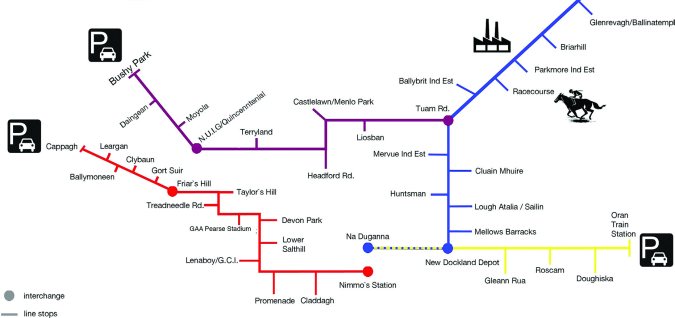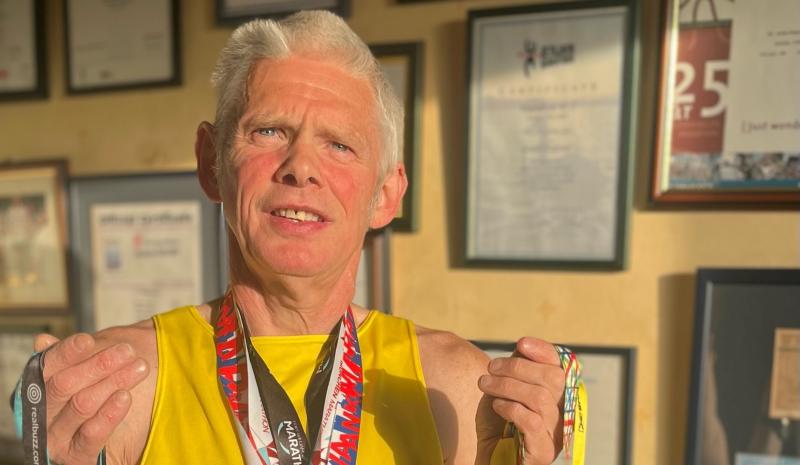News
City light rail system could end the jams

A new advocate for a light rail system in Galway has designed a video showing how the four-line tram system would work, claiming it would virtually eradicate traffic jams at the four main congestion points through which 77,000 commuters pass each day.
Joe Kelly insists that based on costings produced by Government consultants, the system would pay for itself within seven years when it would start to turn a yearly profit of €97m.
He has estimated that Galway’s version of the LUAS or the SUIG – Solas Uirbeach Iarnrod na Gaillimhe – as he has labelled, would cost between €500m and €600m to build.
He predicted that for an adult fare of €5 a day, the city’s beleaguered motorists dragged out of their cars to save money on fuel and parking. It would also see private investors willing to back the project, with annual receipts racking up to €100m.
In a presentation on Monday to Green Drinks Galway, a group which holds free public talks on environmental topics, the native of Mervue explained the four line system contained two integrated hybrid bus lines and four park and ride centres to encourage motorists from outside of the city to leave their cars behind.
It went through all the main areas where workers, residents and students congregated and dealt with congestions at four key commuter notes – Claregalway, Oranmore, Barna and Moycullen.
One line went along a route from the airport, along Briarhill, the racecourse, Lough Atalia and terminating at the Docks. The second started at Cappagh Park, stopping in Taylor’s Hill, the Prom, the Claddagh and finishing at Nimmos Pier. The third line began at Bushy Park and took in NUIG, Headford Road, Liosbán and the Tuam Road, with a fourth line from Oranmore, through Doughiska and onto the Docks.
Joe, 34, who was reared in Claregalway, has a business degree from the University of Limerick and a post graduate diploma in geography and planning studies from University College Cork. He is currently studying e-business analysis at NUIG. After stints working in Italy and Germany, he began working on proposals for light rail systems for Galway and Limerick and over the last two years has produced online videos outlining his proposals. So far, he has not got a penny for all his efforts. But he is hoping to attract the interest of potential investors.
“My motives are benevolent – for anyone living or working in Galway the congestion is horrendous. I wanted to come up with a system which would solve the congestion, generate tourism and create jobs – this is about safeguarding the environment for future generations by creating a more responsible, sustainable transport system,” he insisted.
He claims his system is far more comprehensive and represents better value for money than the one proposed by a consortium of business leaders some years back known as GLUAS – it was a two line system over 19km serving 40% of Galway residents and costing in the region of €200m.
Only last April, the former transport minister Leo Varadkar said that LUAS-style trams for other cities were dead in the water. His department was focusing on cheaper alternatives in cities such as Galway such as bus lanes, green routes, cycle lanes and safety measures for pedestrians and cyclists.
“The Government spend €880m on defence, if they can put down €600m to the border counties for a peace campaign – when they’re not at war – surely fund a light rail system in Galway.”
An independent online poll some years back found that 80% of the people of Galway supported a tram system.
Connacht Tribune
West has lower cancer survival rates than rest

Significant state investment is required to address ‘shocking’ inequalities that leave cancer patients in the West at greater risk of succumbing to the disease.
A meeting of Regional Health Forum West heard that survival rates for breast, lung and colorectal cancers than the national average, and with the most deprived quintile of the population, the West’s residents faced poorer outcomes from a cancer diagnosis.
For breast cancer patients, the five-year survival rate was 80% in the West versus 85% nationally; for lung cancer patients it was 16.7% in the west against a 19.5% national survival rate; and in the West’s colorectal cancer patients, there was a 62.6% survival rate where the national average was 63.1%.
These startling statistics were provided in answer to a question from Ballinasloe-based Cllr Evelyn Parsons (Ind) who said it was yet another reminder that cancer treatment infrastructure in the West was in dire need of improvement.
“The situation is pretty stark. In the Western Regional Health Forum area, we have the highest incidence of deprivation and the highest health inequalities because of that – we have the highest incidences of cancer nationally because of that,” said Cllr Parsons, who is also a general practitioner.
In details provided by CEO of Saolta Health Care Group, which operates Galway’s hospitals, it was stated that a number of factors were impacting on patient outcomes.
Get the full story in this week’s Connacht Tribune, on sale in shops now, or you can download the digital edition from www.connachttribune.ie. You can also download our Connacht Tribune App from Apple’s App Store or get the Android Version from Google Play.
Connacht Tribune
Marathon Man plans to call a halt – but not before he hits 160 races

On the eve of completing his 150th marathon, an odyssey that has taken him across 53 countries, Loughrea’s Marathon Man has announced that he is planning to hang up his running shoes.
But not before Jarlath Fitzgerald completes another ten races, making it 160 marathons on the occasion of his 60th birthday.
“I want to draw the line in 2026. I turn 57 in October and when I reach 60 it’s the finishing line. The longer races are taking it out of me. I did 20 miles there two weeks ago and didn’t feel good. It’s getting harder,” he reveals.
“I’ve arthritis in both hips and there’s wear and tear in the knees.”
We speak as he is about to head out for a run before his shift in Supervalu Loughrea. Despite his physical complaints, he still clocks up 30 miles every second week and generally runs four days a week.
Jarlath receives injections to his left hip to keep the pain at bay while running on the road.
To give his joints a break, during the winter he runs cross country and often does a five-mile trek around Kylebrack Wood.
He is planning on running his 150th marathon in Cork on June 4, where a group of 20 made up of work colleagues, friends and running mates from Loughrea Athletics Club will join him.
Some are doing the 10k, others are doing the half marathon, but all will be there on the finishing line to cheer him on in the phenomenal achievement.
Get the full story in this week’s Connacht Tribune, on sale in shops now, or you can download the digital edition from www.connachttribune.ie. You can also download our Connacht Tribune App from Apple’s App Store or get the Android Version from Google Play.
CITY TRIBUNE
Galway ‘masterplan’ needed to tackle housing and transport crises

From the Galway City Tribune – An impassioned plea for a ‘masterplan’ that would guide Galway City into the future has been made in the Dáil. Galway West TD Catherine Connolly stated this week that there needed to be an all-inclusive approach with “vision and leadership” in order to build a sustainable city.
Deputy Connolly spoke at length at the crisis surrounding traffic and housing in Galway city and said that not all of the blame could be laid at the door of the local authority.
She said that her preference would be the provision of light rail as the main form of public transport, but that this would have to be driven by the government.
“I sat on the local council for 17 years and despaired at all of the solutions going down one road, metaphorically and literally. In 2005 we put Park & Ride into the development plan, but that has not been rolled out. A 2016 transport strategy was outdated at the time and still has not been updated.
“Due to the housing crisis in the city, a task force was set up in 2019. Not a single report or analysis has been published on the cause of the crisis,” added Deputy Connolly.
She then referred to a report from the Land Development Agency (LDA) that identified lands suitable for the provision of housing. But she said that two-thirds of these had significant problems and a large portion was in Merlin Park University Hospital which, she said, would never have housing built on it.
In response, Minister Simon Harris spoke of the continuing job investment in the city and also in higher education, which is his portfolio.
But turning his attention to traffic congestion, he accepted that there were “real issues” when it came to transport, mobility and accessibility around Galway.
“We share the view that we need a Park & Ride facility and I understand there are also Bus Connects plans.
“I also suggest that the City Council reflect on her comments. I am proud to be in a Government that is providing unparalleled levels of investment to local authorities and unparalleled opportunities for local authorities to draw down,” he said.
Then Minister Harris referred to the controversial Galway City Outer Ring Road which he said was “struck down by An Bord Pleanála”, despite a lot of energy having been put into that project.
However, Deputy Connolly picked up on this and pointed out that An Bord Pleanála did not say ‘No’ to the ring road.
“The High Court said ‘No’ to the ring road because An Bord Pleanála acknowledged it failed utterly to consider climate change and our climate change obligations.
“That tells us something about An Bord Pleanála and the management that submitted such a plan.”
In the end, Minister Harris agreed that there needed to be a masterplan for Galway City.
“I suggest it is for the local authority to come up with a vision and then work with the Government to try to fund and implement that.”















